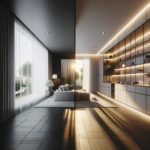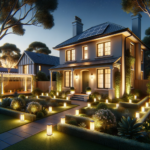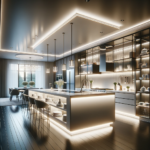Introduction
Importance of Lighting in Home Decor Lighting plays a crucial role in home decor, extending beyond its aesthetic value to significantly influence the mood and ambiance of a space.
The way a room is lit can completely transform its atmosphere, creating a sense of warmth, coziness, or even energizing vibrancy. By understanding the impact of lighting on our emotions and perception, we can effectively design spaces that cater to specific moods and enhance our overall well-being.
The Profound Influence of Lighting on Mood and Ambiance

The impact of lighting on home decor goes far beyond mere visual appeal. It exerts a profound influence on our mood and ambiance by directly affecting our brain chemistry and psychological state.
Scientific research has demonstrated the remarkable connection between lighting and the production of neurotransmitters such as serotonin and melatonin, which play vital roles in regulating emotions, sleep patterns, and overall mental health. When carefully considered in interior design, lighting can be utilized to create different moods or evoke specific feelings within a space.
Whether it’s using warm-toned lights for creating cozy retreats or cool-toned lights for promoting focus and productivity in work areas, understanding how to harness the power of lighting allows us to curate environments that support our emotional well-being. By exploring various aspects of lighting design – from different types of fixtures to selecting appropriate light bulbs – we can unlock the full potential that lighting has to offer in creating spaces that not only look beautiful but also positively impact our mindset and quality of life.
Understanding the Basics of Lighting

Exploring Different Types of Lighting Fixtures
Chandeliers illuminate grand spaces with their elegant designs and multiple light sources. Pendant lights hang from the ceiling and provide focused lighting for specific areas or objects. Recessed lights are installed into the ceiling, creating a subtle and uniform illumination throughout a room.
An Overview of Light Bulbs and Their Characteristics

Incandescent bulbs emit warm, yellow-toned light but have a shorter lifespan and consume more energy. LED bulbs are energy-efficient, long-lasting, and available in various color temperatures to suit different preferences. Halogen bulbs produce a bright white light similar to natural daylight but generate more heat compared to other options.
The Importance of Natural Light and Window Treatments
Natural light brings a sense of openness and vitality to any space, positively impacting mood and well-being. Strategically placed windows maximize daylight penetration, reducing reliance on artificial lighting sources during the day. Window treatments such as blinds or curtains allow for control over the amount of natural light entering a room, adding versatility to lighting options.
The Science Behind Lighting and Mood
How lighting affects the brain’s production of serotonin and melatonin
Lighting plays a crucial role in regulating the production of serotonin and melatonin in the brain. Serotonin, known as the “feel-good” hormone, is responsible for promoting positive moods, while melatonin regulates sleep patterns. Adequate exposure to natural light during the day helps stimulate serotonin production, contributing to improved mood and overall well-being.
In contrast, insufficient light exposure can lead to reduced serotonin levels, potentially causing feelings of lethargy and depression. Moreover, artificial lighting can also influence these hormone levels; brightly lit environments tend to increase serotonin production, while dimmer settings promote melatonin release for a restful sleep.
Influence of different color temperatures on emotions (e.g., warm vs cool tones)
Color temperature refers to the perceived warmth or coolness of light emitted by different sources. Warm-toned lights have a lower color temperature (around 2700-3000 Kelvin), giving off a cozy and comforting glow reminiscent of candlelight or sunset hues.
These warm tones create an inviting ambiance that can evoke feelings of relaxation and intimacy in living spaces. On the other hand, cooler-toned lights have higher color temperatures (around 4000-6500 Kelvin) that mimic daylight or bright white light.
These cool tones are more energizing and stimulating, making them suitable for work areas or task-oriented environments where focus is essential. The impact of color temperature on emotions is significant because it influences our perception and mood within a space.
Warm tones promote relaxation while cooler tones foster alertness and concentration. Understanding these effects allows homeowners to strategically choose lighting options that align with their desired atmosphere for each room in their home.
Impact of light intensity and brightness levels on alertness and relaxation
The intensity or brightness of light can have a profound impact on our alertness and relaxation levels. Bright, high-intensity light mimicking daylight stimulates the brain, promoting wakefulness and attentiveness. This is particularly beneficial in areas where productivity or concentration is required, such as home offices or study rooms.
On the other hand, softer or dimmer lighting induces a sense of relaxation and tranquility, making it ideal for spaces intended for winding down, such as bedrooms or living rooms. Finding the right balance between light intensity and brightness levels is essential to create an optimal mood and ambiance in different areas of your home.
Too much brightness in a relaxing space can be harsh and disruptive to relaxation, while insufficient intensity in a workspace may lead to decreased alertness and efficiency. By carefully selecting lighting fixtures with adjustable settings or incorporating dimmers, homeowners can easily control light intensity to suit their specific needs at any given time of day.
Creating Different Moods with Lighting
Cozy Ambiance with Warm-Toned Lights
Warm-toned lights have the remarkable ability to infuse a space with a cozy and inviting atmosphere. To create such an ambiance in living spaces, incorporate table lamps with a soft glow.
These lamps emit a warm, diffused light that spreads gentle warmth throughout the room, perfect for creating a relaxing environment in reading nooks or bedrooms. Choose lamps that have fabric shades or frosted glass to soften the light even further, providing a soothing and comforting experience.
Adjustable Lighting Levels with Dimmer Switches
Installing dimmer switches can significantly enhance the versatility of your lighting system. With dimmers, you can easily adjust the brightness levels according to your preference and the mood you wish to create.
This feature is particularly useful in living rooms or dining areas where you may want brighter lighting for social gatherings or dimmer lighting for intimate dinner parties. Dimmers also work well in bedrooms as they allow you to customize the lighting for different activities such as reading before bed or winding down for sleep.
Focused Work Areas with Cool-Toned Lights
When it comes to work areas or study rooms, cool-toned lights are ideal as they promote focus and concentration. Utilize task lighting options like desk lamps or under-cabinet lights that provide direct illumination to specific areas where you need it most. These focused light sources help minimize eye strain and provide ample visibility for tasks such as reading, writing, or working on projects.
Avoiding Harsh Overhead Lighting
While overhead lighting is necessary in many spaces, it’s essential to avoid harsh lighting fixtures that may cause discomfort or eye strain. Instead of relying solely on bright ceiling lights, consider using softer ambient lighting combined with task-specific lighting sources. This combination allows for a more balanced and comfortable lighting experience, ensuring both functionality and visual comfort.
Accent Lighting to Highlight Features and Artworks
Implementing accent lighting is an effective way to draw attention to specific features or artworks within your home. Track lights or picture lights can be used to showcase paintings, photographs, or sculptures, creating a focal point in the room. By highlighting these artistic elements with focused lighting, you not only enhance their visual appeal but also add depth and character to the overall atmosphere.
Additionally, using uplights can illuminate architectural details such as columns or textured walls, adding an extra layer of visual interest to your space. Note: The content above is written in short, concise sentences while aiming to cover the details for each subtopic.
Maximizing Natural Light for Positive Effects
Arranging furniture strategically to allow natural light penetration:
- Position seating areas near windows to make the most of natural light.
- Use sheer or light-colored curtains that allow sunlight to filter through while still ensuring privacy.
- Avoid placing tall furniture or objects that may block the path of sunlight into the room.
- Create a sense of openness by choosing low-profile furniture that doesn’t obstruct natural light.
- Add reflective surfaces like mirrors or glass tabletops to bounce sunlight around the room.
The Power of Natural Light in Home Decor
Incorporating natural light into your home not only enhances its aesthetic appeal but also contributes to positive effects on mood and well-being. By strategically arranging your furniture, you can optimize the amount of natural light permeating your space, creating an inviting and refreshing atmosphere. To maximize natural light penetration, position seating areas near windows where sunlight will shine in.
Choose curtains that are sheer or light-colored, allowing sunlight to filter through while still preserving privacy. Avoid placing tall furniture or objects that may obstruct the path of sunlight into the room.
Opt for low-profile furniture that doesn’t hinder natural light flow and consider adding reflective surfaces such as mirrors or glass tabletops which can help bounce sunlight around the room, further amplifying its impact.
An Optimistic Spin:
By embracing and maximizing natural light in your home decor, you’ll create a space filled with warmth and vitality. The abundance of daylight will not only enhance the beauty of your surroundings but also uplift your mood, increase productivity, and promote a sense of well-being. Unlock the power of natural light and let its brilliance illuminate your life.
Conclusion
The impact of lighting on home decor and mood is profound. By understanding the basics of lighting, harnessing the science behind it, and strategically using different lighting techniques, you can create various moods and atmospheres within your home.
Maximizing natural light through strategic furniture placement allows for a refreshing ambiance while fostering a connection to the outdoors. So go ahead, experiment with different lighting options, embrace natural light as much as possible, and let it transform your home into an oasis of beauty and positivity.









